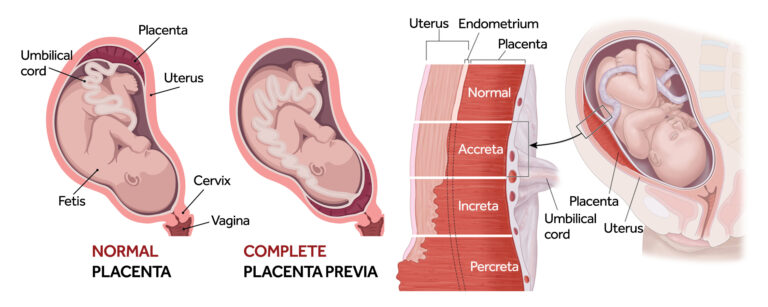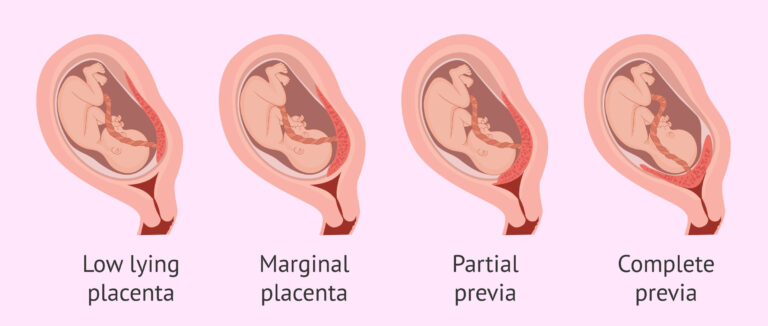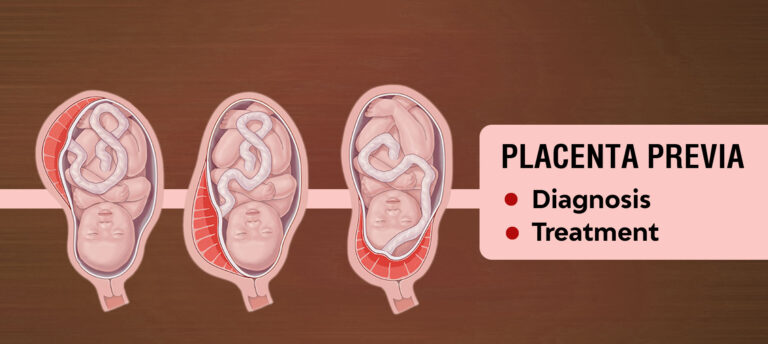PLACENTA PREVIA – SYMPTOMS, CAUSES, AND TREATMENT
The placenta is a structure that develops within your uterus during pregnancy, supplying oxygen and nutrition to and removing wastes from your baby. The placenta attaches to your baby through the umbilical cord. In most pregnancies, the placenta connects at the top or side of the uterus.
Placenta previa happens when a baby’s placenta partially or completely covers the mother’s cervix — the outlet for the uterus. Placenta previa could cause severe bleeding during pregnancy and delivery.
If you have placenta previa, you may bleed throughout your pregnancy and during your delivery. Your health care provider will suggest avoiding activities that may cause contractions, including having sex, douching, using tampons, or engaging in activities that could increase your risk of bleeding, like running, squatting, and jumping.
You will require a C-section to deliver your baby if the placenta previa does not resolve.
 PLACENTA PREVIA SYMPTOMS
PLACENTA PREVIA SYMPTOMS
Bright red vaginal bleeding without pain during the second half of pregnancy is the primary sign of placenta previa. Some women get contractions too.
In many women diagnosed with placenta previa at an early stage of pregnancies, the placenta previa resolves. As the uterus grows, it may increase the distance between the cervix and the placenta. The more the placenta covers the cervix and the later in the pregnancy that it stays over the cervix, the less likely it is to resolve itself.
WHEN SHOULD YOU SEE A DOCTOR?
If you have vaginal bleeding during your second or third trimester, contact your doctor immediately. If the bleeding is severe, look for emergency medical care.

PLACENTA PREVIA CAUSES
The accurate cause of placenta previa is not known.
PLACENTA PREVIA RISK FACTORS
Placenta previa is more frequent among women who:
- Have had a baby
- Have scars on the uterus, like from previous surgery, involving cesarean deliveries, uterine fibroid removal, and dilation and curettage
- Had placenta previa with a previous pregnancy
- Are carrying more than one fetus
- Are age 35 or older
- Are of a race other than white
- Smoke
- Use cocaine
PLACENTA PREVIA COMPLICATIONS
If you have placenta previa, your health care professional will monitor you and your baby to lower the risk of these severe complications:
Bleeding – Severe, potentially life-threatening vaginal bleeding (hemorrhage) could happen during labor, delivery, or in the first few hours after delivery.
Preterm birth – Severe bleeding might prompt an emergency C-section before your baby is full term.
PLACENTA PREVIA DIAGNOSIS
Placenta previa is diagnosed during an ultrasound, either during a routine prenatal appointment or after an incident of vaginal bleeding. Most cases of placenta previa are diagnosed at the time of a second-trimester ultrasound examination.
Diagnosis may need a combination of abdominal ultrasound and transvaginal ultrasound, which is performed with a wand-like device placed within your vagina. Your health care professional will take care of the transducer’s location in your vagina so as not to disturb the placenta or cause bleeding.
If your health care professional suspects placenta previa, he or she will avoid routine vaginal examinations to lower the risk of heavy bleeding. You may require additional ultrasounds to check the position of your placenta during your pregnancy to see if placenta previa resolves.
PLACENTA PREVIA TREATMENT
There is no medical or surgical treatment to heal placenta previa, but there are several alternatives to control the bleeding caused by placenta previa.
Management of the bleeding depends upon several factors, involving:
- The amount of bleeding
- Whether the bleeding has stopped
- How far along your pregnancy is?
- Your health
- Your baby’s health
- Location of the placenta and the baby
If the placenta previa does not resolve during your pregnancy, the purpose of the treatment is to help you get as close to your deadline as possible. Almost all women with unresolved placenta previa need a caesarean delivery.

For little or no bleeding
Your health care professional may recommend rest, which means avoiding activities that could trigger bleeding, like sex and exercise.
Be prepared to look for emergency medical care if you start to bleed. You will need to be able to get to the hospital quickly if bleeding continues or gets heavier.
If the placenta is low lying but does not cover the cervix, you may be able to have a vaginal delivery. Your health care professional will discuss this option with you.
For heavy bleeding
Heavy bleeding needs immediate medical attention at your nearest emergency health facility. Severe bleeding may need a blood transfusion.
Your health care professional will likely plan a C-section as soon as the baby could be delivered safely, ideally after 36 weeks of pregnancy. Although, you might need to have an earlier delivery if heavy bleeding continues or if you have multiple bleeding incidents.
If your delivery is planned before 37 weeks, your doctor will provide you corticosteroids to help your baby’s lungs develop.
For bleeding that won’t stop
If your bleeding cannot be controlled or your baby is in distress, you will likely need an emergency C-section — even if the baby is premature.
If you or anyone you know is suffering from placenta previa, our expert providers at Specialty Care Clinics will take care of your health and help you recover.
Call (469) 545-9983 to book a telehealth appointment for an at-home check-up.
